|
|
|
In huge emergency exercise, an earthquake that
didn't really hit Seattle had a big impact on
Boundary County |
|
June 13, 2016 |
 So
an earthquake didn't really happen at Seattle
and the west coast last week, but that non-quake
had a big impact on Boundary County, Idaho. So
an earthquake didn't really happen at Seattle
and the west coast last week, but that non-quake
had a big impact on Boundary County, Idaho.
In one of the biggest disaster drills ever
undertaken, a four-day long scenario was enacted
and drilled last week. The drill scenario was a
9.0 magnitude earthquake, followed by a huge
tsunami, occurring in a zone along the west
coast extending from northern California up into
southern British Columbia. This (drill)
earthquake and tsunami destroyed significant
areas of Seattle and Portland, Oregon, and other
coastal areas from California to British
Columbia, covering an area with a population of
over 8 million people who live in the zone.
A real earthquake and tsunami in that area,
known seismologically as the Cascadia Zone,
would mean the destruction of bridges, roads,
communications, and other buildings and
infrastructure. Whole towns could be damaged or
destroyed, with accompanying casualties.
"A 9.0 magnitude earthquake along the Cascadia
Subduction Zone and the resulting tsunami is the
most complex disaster scenario that emergency
management and public safety officials in the
Pacific Northwest could face. [This] is an
exercise to address that disaster," FEMA said in
an information release.
The drill exercise, named Cascadia Rising 2016,
which has been in planning stages for about
seven
years according to Governor Otter's office, began last Tuesday, June 7, when the
drill earthquake hit the area. Immediately, upon
the announcement that the "earthquake" had hit,
government agencies, the National Guard, the
military, and a multitude of other entities
large and small went into emergency response
mode to address the situation.
How did Boundary County become involved in all
of this? The premise was that with all the
destruction on the coast, hundreds of thousands
or more of displaced people would tend to move
inland, away from the destruction on the coast,
seeking protection, shelter, and help.
Eventually that wave of people would begin
heading toward or would be directed to safer
inland areas. And that is where Boundary County
and other areas in Idaho and eastern Washington
came into play.
When the drill earthquake hit the coast last
Thursday, the drill responses began. It was
estimated that 20,000 people were involved as
part of the drill throughout the Pacific
Northwest, including federal agencies, the U.S.
military, and state and local emergency response
managers from Washington, Oregon and Idaho,
Native American tribes and emergency management
officials in British Columbia.
Some examples: Sailors of the U.S. Navy built a
temporary camp on an island in the Puget Sound
to help with emergency response. Supplies were
parachuted from Chinook helicopters, along with
paratroopers, into the Shelton, Washington area,
where they set up an operations center. Part of
the logistics of the disaster drill was the
assumption that the airfield at Shelton would be
the airfield closest to the Washington coast to
survive the earthquake.
In other emergency drills, the Washington
National Guard practiced decontaminating
vehicles and first responders. The U.S. Army
sent a team to set up a petroleum distribution
system. Also planned for the drill was
deployment of the National Guard to check the
integrity of area airfields, a military chemical
company team to address hazardous materials
dangers, and other organizations working to set
up a water purifying system.
Add to all of this the massive search and rescue
that would be required (a team from the Kentucky
National Guard was scheduled to be deployed to
help alongside Pacific Northwest teams, along
with other out-of-area entities and agencies).
Provision of emergency medical care was also
planned, as it was assumed that no hospital
would remain functional west of the I-5 freeway.
Twitter communications ongoing throughout the
massive drill showed ham radio operators
communicating and helping to coordinate
activities, helicopters shipping medical
supplies, Emergency Management Centers filled
with staff, and notices from the National
Weather Service.
Two days into the drill, on Thursday, June 9,
the wave of impact from the disaster hit Idaho
and Boundary County. The Panhandle Health
District set up a medical needs shelter in Coeur
d'Alene, and emergency response teams in Coeur
d'Alene had to deal with the scenario of a plane
carrying evacuees crash landing at the airport.
Here in Boundary County, an Emergency Response
Center was activated and operated for the first
time, that facility going up at the site of the
Search and Rescue Building on Riverside Street.
As this was the first time such a center had
been activated, "Most of the participants
involved in the operation were somewhat
concerned as to how it would go, would we know
what to do, and could we get it done in a timely
fashion," said Michael Meier, Boundary County
Public Information Officer.
(Story continues below this photo)
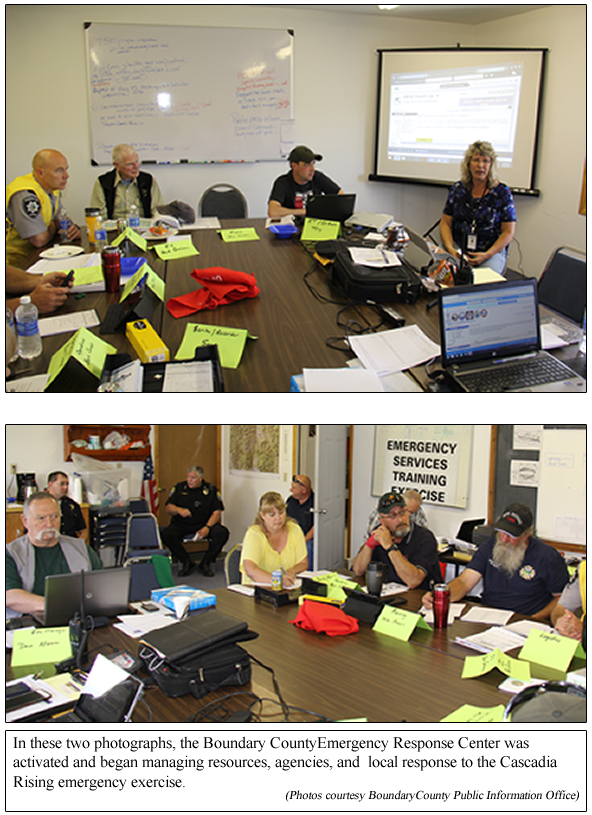
Once set up and established, the county's
Emergency Response Center was confronted with a
multitude of emergency issues to deal with
resulting from the Cascadia Rising drill
earthquake and tsunami, and its Boundary County
aftermath and spillover.
"We had traffic backed up for miles on Highway
95 due to refugees from the devastated coast,
including the Long Bridge in Sandpoint being
closed," said Mr. Meier. "We also had gasoline,
hotel accommodations, and food shortages to deal
with. And to make it even more fun, the hospital
received elderly patients from a Seattle nursing
home, filling the hospital, which already had
other emergencies already in progress," he said.
Other tasks the Emergency Response Center dealt
with included setting up Red Cross shelters at
the schools, the National Guard Armory, and the
Fairgrounds for displaced people.
As Mr. Meier noted above, part of the drill for
Boundary County included a busload full of
displaced nursing home residents who had been
directed to Boundary Community Hospital for
evaluation and appropriate care and housing. A
real bus filled with teen-aged actors playing
the roles of the nursing home residents actually
arrived at the hospital, where the hospital
staff had to mobilize their resources to deal
with the sudden influx of people who needed to
be medically evaluated and to have proper
dispositions determined. Calling in extra staff,
nurses, and physicians, the hospital spent much
of Thursday morning in drill and exercise mode,
evaluating and dealing with this busload of
evacuee patients.
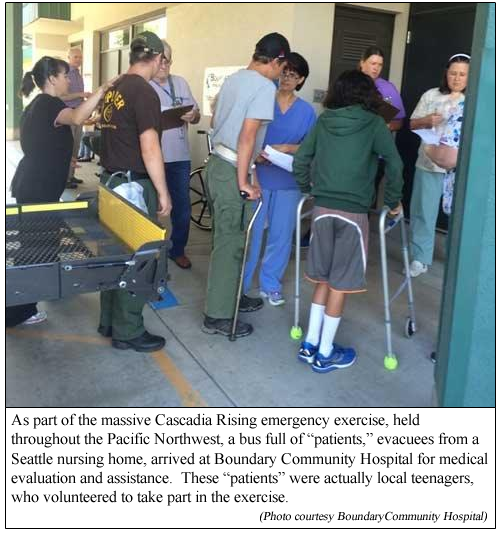
Elsewhere in Boundary County, ham radio
operators worked during the drill to keep
emergency communications up and running, and
providing assistance where needed during the
emergency drill. Mr. Meier's Public Information
Office issued emergency notices and directives
along the way, advising the public on issues
ongoing in Boundary County related to the
Cascadia Rising "emergency" drill.
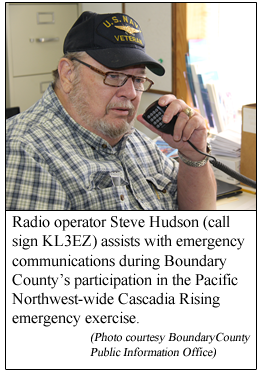 As
the huge, four-day emergency drill came to an
end on Friday, Boundary County was able to pack
up its emergency response teams and equipment. As
the huge, four-day emergency drill came to an
end on Friday, Boundary County was able to pack
up its emergency response teams and equipment.
"Thanks to all the staff in Emergency
Management, those at Boundary Community
Hospital, Law Enforcement, the Red Cross
Representative, and Amateur Radio Emergency
Service (ARES) Amateur Radio Operators who
participated," said Mr. Meier.
"Also thank you to the Official Observer who
judged our ability to perform our duties and
made this event a learning opportunity, and a
point from which to correct any mistakes and
plan better any future catastrophe that may
befall our beautiful North Idaho region.
"To our citizens of Boundary County we also
thank you for supporting your Emergency
Management Team and giving us to chance to learn
and better prepare for protecting you in the
future," he concluded.
Could such an event really happen? Scientists
say there is a zone of tectonic plates lying
offshore of the West Coast from northern
California stretching up into British Columbia.
[We are now talking real world—this is not a
drill]. This zone is called the Cascadia
Subduction Zone. It is a giant fault
approximately 700 miles long. These plates move
irregularly, sometimes get stuck, sometimes
release. With this movement and release,
sometimes the stress among the moving plates
builds up until it has a sudden break which can
cause huge earthquakes. The world's largest
earthquakes occur along this type of zone,
ranging in magnitude from 8.0 to 9.0 and above.
The largest on record was a magnitude 9.5
earthquake that occurred on the Chilean coast in
1960.
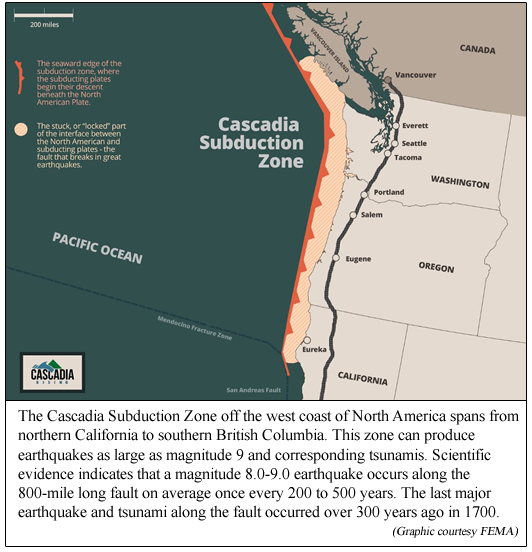
Within the past 12 years, earthquakes from
subduction zones of this type, and their
accompanying tsunamis, occurred in Indonesia
(2004), Chile (2010), and most recently in Japan
(2011). Those disasters taken together caused
nearly 250,000 fatalities.
The last big earthquake at the West Coast's
Cascadia Subduction Zone occurred in 1700, which
experts estimate caused an earthquake of
magnitude 9.0.
That was 316 years ago. Experts have determined
that big earthquakes like this happen in the
Cascadia Zone on average once every 200 to 500
years. Though the next big quake can't be
predicted, with the last one happening 316 years
ago, the next one could come unpredictably at
any time.
Because of that, one of the largest disaster
drills ever was held just last week. And
Boundary County's emergency response teams and
facilities were called upon to play their part
in the huge drill.
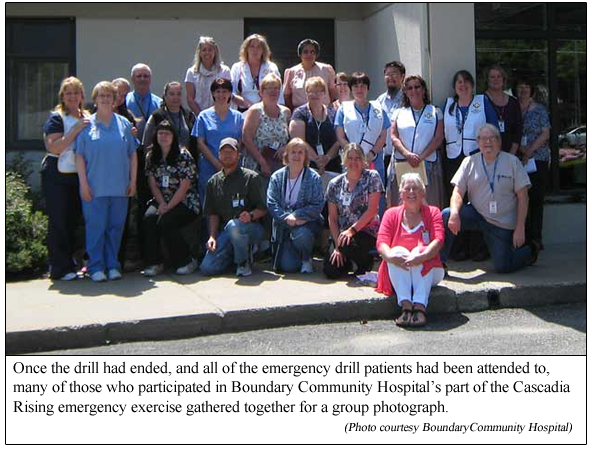
|
|
|
|
Questions or comments about this
article?
Click here to e-mail! |
|
|
|
|

